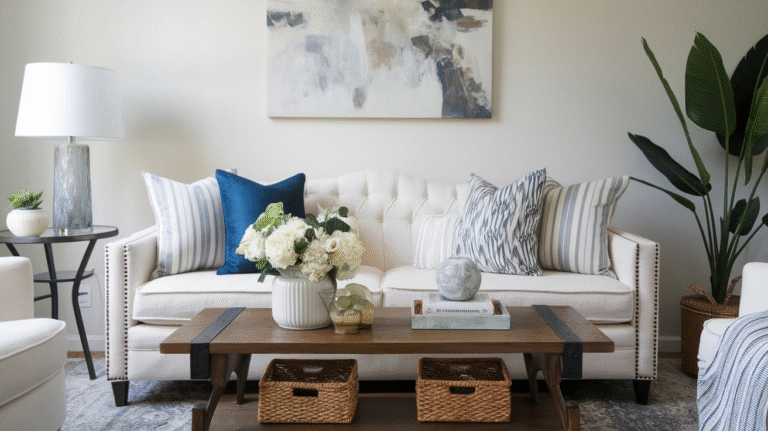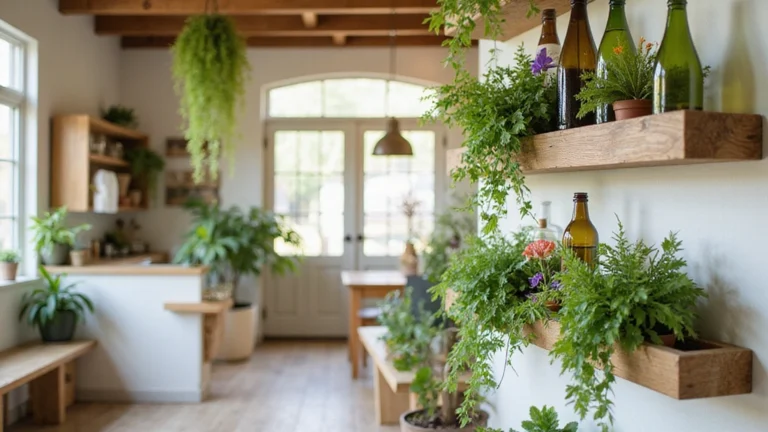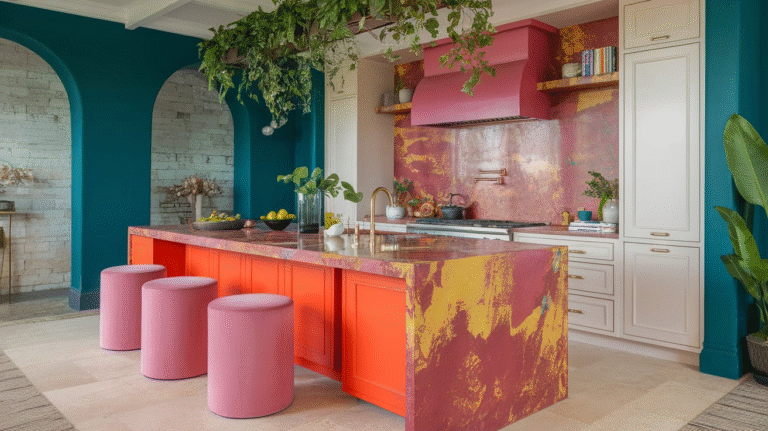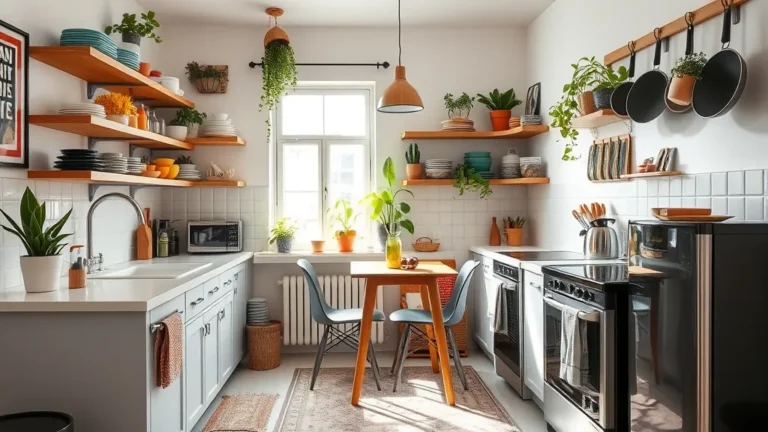21 Living Room Partition Ideas (Practical, Stylish & Space-Smart)
Let’s face it — open floor plans look stunning on Pinterest, but in real life? Sometimes you just need a little separation between the chaos of your living room and the calm of your dining or work area.
That’s where living room partitions come in — subtle dividers that define spaces without closing them off. Whether you live in a studio apartment or a sprawling home, smart partition ideas can change how you experience your space.
Here are 21 clever living room partition ideas to bring structure, style, and sanity back into your open space.
1. Wooden Slats: Airy and Architectural
Wooden slat partitions are a modern favorite — think vertical lines that add rhythm without blocking light. They’re sleek, functional, and can instantly make a room look taller.
They’re ideal if you want separation without complete isolation. The best part? You can choose natural oak for warmth, walnut for depth, or even painted finishes for contrast. If you’re handy, this can even be a DIY weekend project.
Pro tip: Keep slats about 2–3 inches apart for that perfect balance of privacy and openness. Expect installation costs between $300–$1,000, depending on material and size.
2. Glass Partitions: Let There Be Light
If you want division without losing brightness, glass partitions are unbeatable. They maintain an open, airy flow while still defining zones. Choose from clear, frosted, or ribbed glass to match your décor style.
Framed glass partitions in black metal are trending — they offer a hint of industrial chic that fits modern and contemporary interiors.
Stats: According to interior design data from Houzz, glass partitions can increase natural light penetration by up to 25%, making your living area feel larger and more inviting.
3. Sliding Barn Doors: Rustic with Function
If you love farmhouse or industrial aesthetics, sliding barn doors make a bold statement. They’re practical too — instead of swinging open, they glide neatly along a track.
You can choose reclaimed wood for texture or painted panels for a cleaner look. And when open, they completely disappear into the wall, giving you flexibility.
Average cost: Between $400–$1,200, depending on material and hardware.
Pro tip: Add a soft-close mechanism to avoid the dramatic slam.
4. Bookcase Partitions: Storage Meets Style
Why choose between function and beauty when you can have both? A floor-to-ceiling bookshelf makes a fantastic partition — offering storage, display, and division all at once.
Use it to showcase books, art pieces, or plants. It subtly defines areas while still feeling connected.
Personal tip: I once used an IKEA KALLAX shelf as a room divider in my apartment — it not only split the space but also became a conversation piece.
Cost: Around $150–$800, depending on the size and quality.
5. Folding Screens: Portable Privacy
A classic solution that never goes out of style — folding screens. Lightweight, affordable, and mobile, they’re perfect for renters or small spaces. Choose woven rattan for boho flair or lacquered panels for elegance.
You can fold them away when you need an open feel or move them around for quick layout changes.
Price: Usually $80–$300, depending on design.
Bonus: No tools, no construction — just instant transformation.
6. Curtains: Soft and Flexible Boundaries
Curtains as partitions might sound simple, but when done right, they’re pure magic. They add softness, texture, and versatility to your living room. Pull them back for openness or close them to create a cozy nook.
Use ceiling-mounted tracks for a seamless look. Sheer fabrics keep it light, while velvet or linen adds drama.
Tip: Use blackout curtains if you need real privacy or sound dampening.
Cost: Around $100–$400 depending on fabric and length.
7. Metal Screens: Modern and Minimal
For a sleek, contemporary vibe, metal partitions deliver both form and function. These laser-cut designs come in geometric, floral, or abstract patterns — adding visual intrigue while defining zones.
They’re durable, stylish, and ideal for homes aiming for an industrial or modern luxe feel.
Cost: Around $400–$1,000, but it’s a long-term investment that lasts decades.
8. Half Walls: The Subtle Divider
A half wall or pony wall creates clear spatial definition without blocking sightlines. It’s great for separating a living area from a dining room or entryway while maintaining openness.
You can top it with plants, glass panels, or even a counter for added function.
Stat: Real estate experts say open layouts with partial divisions improve perceived space by 15–20%, compared to fully enclosed rooms.
Cost: $500–$2,000, depending on materials and finish.
9. Indoor Plants and Green Dividers
Why not let nature handle the decor? Tall indoor plants or vertical gardens make beautiful natural partitions. Think bamboo, areca palm, or fiddle-leaf figs — they add privacy and purify the air.
You can use planter boxes, hanging systems, or modular plant walls for flexible layouts.
Fun fact: NASA studies show indoor plants can reduce toxins and increase oxygen levels, improving indoor air quality by up to 60%.
Cost: Roughly $50–$500, depending on plant type and setup.
10. Lattice Panels: Classic and Customizable
Wooden lattice panels are an old favorite reinvented for modern homes. They offer partial visibility while creating interesting light patterns.
Paint them white for a coastal feel or keep them natural for rustic warmth. They also double as trellises for climbing plants.
Cost: Between $150–$600, depending on customization.
Tip: Add LED strips behind them for stunning nighttime ambiance.
11. Floating Shelves: Functional and Light
For a subtle approach, install floating shelves between zones. They’re less bulky than full bookcases but still provide space for display and storage.
Use them to hold decor, small plants, or art pieces. They break up the space visually without overwhelming it.
Budget range: $100–$400 for a decent setup.
Design tip: Keep spacing symmetrical to avoid a cluttered look.
12. Beaded or Rope Dividers: Boho Creativity
If your style leans playful or eclectic, rope or beaded dividers can be your go-to. They’re lightweight, inexpensive, and totally customizable.
Macramé panels or wooden beads add texture and personality to an otherwise bland room. Plus, they move gently with air — giving your space a relaxed, artistic vibe.
Cost: Around $50–$200, depending on materials.
13. Sliding Glass Doors: Transparency with Control
A sliding glass partition offers the flexibility to open or close spaces as needed. Unlike regular glass walls, these can glide open — perfect for transitioning between living and dining zones.
Tinted or frosted options enhance privacy while maintaining brightness. They’re great for modern apartments or minimalist homes.
Average cost: $1,000–$3,500, depending on glass and track quality.
14. Fabric Panels: Custom Soft Dividers
If you want to soften the mood, fabric panels are a creative solution. Mounted on frames or tension rods, they bring color and warmth without bulk.
You can easily change fabrics seasonally — linen in summer, velvet in winter. They’re sound-absorbing too, making your living area more acoustically comfortable.
Cost: Around $100–$300 for DIY, or up to $700 for custom.
15. Decorative Screens: Art Meets Architecture
Laser-cut MDF or wooden decorative screens are a great way to combine privacy with design. Patterns range from Moroccan to abstract — and they can be painted or left natural.
Use them as stand-alone pieces or attach them to walls or ceilings for semi-permanent division.
Cost: $200–$800, depending on size and design intricacy.
16. Sliding Panels: Flexibility in Motion
For ultimate adaptability, sliding partitions are a dream. You can open them fully for gatherings or close them off when you need separation.
Materials vary — from laminate panels for modern minimalists to bamboo screens for earthy tones.
Pro Tip: Choose ceiling-mounted tracks to save floor space and maintain a clean look.
Cost: $1,000–$4,000, depending on system quality.
17. Fireplace Divider: Warmth with Purpose
A double-sided fireplace is a luxurious and functional partition. It creates a natural boundary while serving as a stunning focal point for both sides of the room.
This idea works beautifully in open-plan homes, separating living and dining areas while keeping both cozy.
Cost: Around $3,000–$10,000, but it adds serious resale appeal.
Stat: According to Realtor.com, fireplaces can increase home value by up to 12% when integrated attractively.
18. Storage Cabinets: The Practical Partition
A tall storage unit can define space while keeping clutter out of sight. Unlike bookshelves, cabinets offer closed storage, perfect for families or small spaces.
Choose ones with open upper shelves and closed bottoms for the best balance of function and style.
Price range: $300–$1,500, depending on material and brand.
Tip: Match the cabinet finish with your flooring or trim for a cohesive look.
19. Vertical Blinds or Panels: Adjustable Privacy
Vertical blinds aren’t just for windows — they can act as movable partitions. You can tilt them to control light or draw them completely for privacy.
Modern designs feature textured fabric or wood-look slats, far from the dull office blinds of the past.
Cost: $200–$800, making them an affordable choice.
20. Acrylic Panels: Sleek and Subtle
When you need a partition that doesn’t overwhelm, acrylic panels strike the right balance. They’re translucent, lightweight, and modern — ideal for small apartments.
Frosted or tinted options offer a hint of privacy while maintaining visual depth. They’re also impact-resistant and easy to clean.
Price: $150–$500, depending on size and style.
21. Art and Frame Walls: Personalized Separation
Want your divider to double as decor? Use a gallery wall as a visual partition. Large-scale artwork or framed photos arranged between spaces can define zones beautifully.
This approach is particularly effective in open-concept living rooms where structure meets personality.
Design tip: Use consistent frame colors or styles for harmony.
Cost: As low as $100 if you already own artwork.
Conclusion on 21 Living Room Partition Ideas
The truth is, living room partitions aren’t just about separating spaces — they’re about defining experiences. A well-placed divider can make your home feel more functional, cozy, and aesthetically refined.
If you’re after flexibility, go for curtains, folding screens, or sliding panels. For long-term structure, half walls, glass partitions, or shelving units offer architectural appeal. And for those who love personality, plant walls, art dividers, or rope panels bring life and creativity into every corner.
Remember: the goal isn’t to cut your room in half, but to create harmony between openness and intimacy. When done right, partitions don’t separate — they connect spaces in smarter, more beautiful ways.
Your living room deserves that balance — a space that feels both together and apart, like a melody that flows yet changes with each note. Now go on, rethink your layout and let your space tell its own story — one partition at a time.




